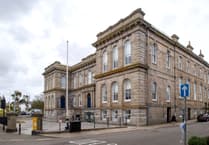WHILE this year’s commemorations and celebration events have focused on the historic 80th anniversary of VE Day – also known as Victory in Europe day – another decisive World War II event that Cornwall played in a part in is set to be commemorated in a place which was one of the locations which played a crucial role in its occurrence.
On May 31, Trebah Gardens will be hosting its annual Military Day, an event co-ordinated by the Royal Cornwall branch of the Parachute Regimental Association. The event will take place from 9.30am until 5pm with events comprising from singing at the top lawn to displays of military vehicles, wreath laying on land and sea and later pipes and drums and further singing on the top lawn. Entry garden fees apply for non-members, although attendance for members of Trebah Gardens for this event is free.
It was on June 1, 1944 that a regiment of 7,500 men from the 29th US Infantry Division, accompanied by tanks, guns and transport embarked from Trebah Beach in ten 150-foot long LST landing craft, taking five days sailing across challenging sea conditions, reaching Omaha Beach.
Cornwall played several important roles in making D-Day, often cited as one of the most pivotal events that turned the chain of events in World War II around and marked the starting point towards not only the liberation of France from the Nazis and their puppet Vichy Government but eventually victory over the Axis Powers.
All across Cornwall played its part in the D-Day landings, playing host to troops from all over the world who were fighting with the Allied countries who were often hidden from view of the aggressors in tent encampments in creeks.
Approximately 27,000 of these men were hidden in the Fal River area, and it was here that despite the cramped conditions, the camouflaged war heroes prepared for the D-Day landings.
They were aided by dummy docks and airstrips, which were put in to place to confuse the enemy and keep them away from the real sites from which the landings would take off from and prior to executing the mission, also known as Operation Overlord, General Eisenhower himself paid a visit to Tolverne, a cottage on the Fal.
Such was the size of the American contingent in late 1943 and early 1944 that Cornwall played host to, including a sizeable number hosted on land that was later redeveloped and now known as the Walker Lines Industrial Estate in Bodmin adjacent to the barracks of the Duke of Cornwall Light Infantry, that Cornwall was at the time sometimes nicknamed ‘almost the 49th state of the union’ in reference to the states that comprise the United States of America.
While memories of the decisive D-Day landings falters in part due to the sands of time and as those who survived Operation Overlord grow old, this year’s D-Day, marking 81 years since the first D-Day landing will nevertheless be a poignant calendar date for remembering and celebrating those who gave the ultimate sacrifice for today’s freedom.



.png?width=209&height=140&crop=209:145,smart&quality=75)

Comments
This article has no comments yet. Be the first to leave a comment.